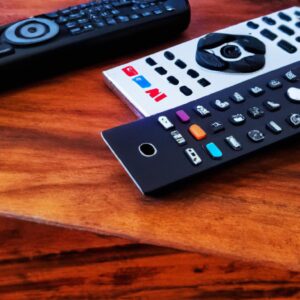Take the Guesswork Out: Compare Roku, Apple TV and Amazon Fire TV

Introduction to Streaming Devices
The world of streaming devices can be quite a confusing one. With so many different types and brands available, it can be hard to know which type is the right one for you. In this guide, we’ll dive deep into the three most popular streaming device options: Roku, Apple TV, and Amazon Fire TV.
Roku is the oldest of the three streaming device types, having been around since 2002. They specialize in streaming movies, TV shows, music, and other content from popular streaming services like Netflix, Hulu, and Amazon Prime Video. Roku also has a wide selection of their own streaming channels and content.
Apple TV was first released in 2007, and it focuses heavily on streaming content from iTunes and other Apple services. It also allows access to many third-party streaming services, and some models even support 4K content. Apple TV also comes with access to the App Store, giving users access to a wide selection of games and apps.
Finally, Amazon Fire TV was introduced in 2014. It is designed to integrate seamlessly with Amazon’s streaming services, such as Prime Video and Music. It also supports a range of third-party services and features 4K content. Fire TV also includes access to Alexa, the voice-activated assistant, allowing users to control their streaming experience with simple voice commands.
In this guide, we’ll take a deep dive into the three streaming devices, comparing them across various categories such as price, installation, content delivery, and more. By the end, you’ll know all about the three streaming device types and be able to make an informed decision on which device is right for you.
Overview of Roku
Roku streaming devices are popular among cord-cutters and those who want a smart home entertainment system. They allow users to easily access streaming services, like Netflix and Hulu, on their TVs. The devices are relatively inexpensive and straightforward to set up. Roku offers several different models, each with its own features and capabilities.
The entry-level Roku Express is a small, portable device that supports both HD and 4K streaming. For those who need more power, the Roku Ultra offers 4K streaming, HDR support, and enhanced voice controls. The Roku Stick+ is also a good choice for streaming 4K content, and it is slightly more powerful than the Express. The Roku Smart Soundbar, meanwhile, can serve as both a streaming device and a sound bar for your television.
The main feature that sets Roku apart from other streaming services is its platform. Roku’s OS allows you to quickly and easily access your favourite streaming services, organize them into channels, and search for specific movies or TV shows. You can also use your phone to control the device, add or remove channels, and browse the streaming library.
Roku also offers several useful features that make streaming easier and more enjoyable. Its “My Feed” feature allows users to set up notifications for when new episodes of their favourite shows become available. It also has a “Private Listening” feature that uses Bluetooth headphones to stream audio without disrupting anyone else in the room. Finally, Roku has an extensive library of games and apps that can be used to further customize the streaming experience.
Overview of Apple TV
Apple is one of the biggest names in technology, and their streaming devices are no exception. With a range of models, it can be hard to keep track of which device will suit your needs.
Apple TV devices comes with access to iTunes and the Apple TV app, giving users a wide variety of content options. Compared to Roku and Fire TV devices, Apple TVs offer streaming at a higher resolution, with up to 4K Ultra HD. They also come with an upgraded remote and more sophisticated voice commands. It’s compatible with iOS devices and can also pair with Bluetooth accessories.
In terms of hardware, Apple TV works with a range of A/V equipment such as sound bars, receivers, and surround sound systems. It’s important to note too that this only applies to certain models such as Apple TV 4K and Apple TV HD. This can come in handy if you want to get the most out of your home theatre setup.
- Compatible with iOS devices
- Streaming available in up to 4K Ultra HD
- Upgraded remote with voice command capabilities
- Option to pair with Bluetooth accessories
- Compatible with various audio and video equipment
Overview of Amazon Fire TV
Amazon Fire TV is an affordable streaming device that offers a wide range of features. It’s a powerful and easy-to-use streaming media player that lets you access over 500,000 movies, TV shows, applications, and games. It uses an Android-based operating system, making it a powerful streaming device for Android users.
The Amazon Fire TV supports HD streaming for all your content, with support for Dolby Digital sound. You can also access Alexa, Amazon’s voice assistant, to control the device with voice commands. With Alexa, you can ask questions, search for content, control your smart home devices, and more.
In terms of content, Amazon Fire TV has access to many popular services, such as Netflix, Hulu, HBO Now, and much more. Plus, the Amazon Appstore provides plenty of apps and games. Plus, you can use the device to control the streaming of audio, video, and photos from your computer or phone.
Unlike Roku and Apple TV, Amazon Fire TV does not have a physical remote control. Instead, you have to rely on the Fire TV remote app for Android or iOS. The app gives you access to all the features of the physical remote, plus voice searching and limited Alexa integration. You can also opt for the optional Fire TV Voice Remote, which adds Alexa integration.
Finally, Amazon Fire TV also supports wired Ethernet connections so you can enjoy speedy streaming and reliable network performance. It also supports Wi-Fi connections, allowing you to stream content without any cables.
Price Comparison
When it comes to streaming devices, one of the biggest factors to consider is price. Each streaming device offers different capabilities and features that may justify an increase in cost, so it’s important to compare prices before making a decision. Here’s a look at what you can expect to pay for the three popular options:
- Roku: Roku offers devices starting at around $30. The more advanced devices tend to cost anywhere from $50-$100.
- Apple TV: Apple TV devices start at $149 for the HD model, and go up to $199 for the 4K model.
- Amazon Fire TV: Amazon Fire TV devices are usually the priciest option, with devices ranging from $50-$150.
It’s important to note that the actual cost of the device is only part of the total cost. All streaming devices require a subscription to access content, which can add up over time. Depending on the type of subscription, the cost can range anywhere from $5-$20 per month. And when it comes to streaming devices from Apple and Amazon, you will need to pay for their respective streaming services (AppleTV+ and Prime Video).
Overall, each streaming device has its own unique advantages and disadvantages when it comes to price. It’s therefore important to consider all of your options before making a decision.
Installation & Setup Process Comparison
Streaming devices are an easy and convenient way to access the content you want. But how easy is it to set them up? Let’s compare the installation and setup process for each of the popular streaming devices.
Roku setup requires you to connect the device to your TV via HDMI and then connect it to wifi. After that, you just have to create a Roku account using a credit card or PayPal, and you’re ready to start streaming.
Apple TV is similarly easy to set up. All you have to do is connect it to your TV via HDMI, power it up, and then follow the onscreen instructions to connect to your wifi and choose which Apple ID to use.
Amazon Fire TV is a bit more involved than the other two devices. First you have to connect the device to your TV and plug it into the power outlet, then connect it to wifi and then register your Amazon account. Finally, you’ll have to download any apps you want to use from the Amazon App Store.
In terms of ease of installation and setup, all three devices are fairly easy to get up and running. But if you want a more hassle-free experience, Roku and Apple TV are probably the best options.
The content of streaming devices is a key factor to consider when determining which one to buy. Each device has its own selection of apps, shows, and movies to choose from. Let’s compare the content delivery options offered by Roku, Apple TV, and Amazon Fire TV.
Roku offers a wide selection of streaming content, with access to more than 5000 streaming channels offering different movies, shows, and live TV. There are free and paid services, so you can pick and choose what you want to watch. Popular options include Netflix, Hulu, and Sling TV.
Apple TV has access to many of the same apps and services as Roku. But they also offer access to iTunes movies, shows, and music. Additionally, they offer exclusive content like Apple TV+ originals.
Amazon Fire TV is similar to Roku and Apple TV in terms of content. It offers access to subscription services like Prime Video, CBS All Access, and Disney+, as well as a variety of free streaming content. Fire TV also has some exclusive features like Alexa voice control.
These are the main differences between the content delivery for each streaming device. With a wide variety of apps and services available, each device provides access to different content. Ultimately, the decision on which device to purchase should be based on what type of content best suits your needs.
Remote Control Comparison
When looking at streaming devices, the type of remote control that comes with each option is a key factor for many consumers. Let’s take a closer look at how each streaming device compares in this category.
Roku Remote Control
The Roku remote control that comes with their streaming devices is simple but functional. It allows you to quickly browse movies and shows, search for specific titles, and use voice commands to find exactly what you’re looking for. The remote also has volume and power buttons, perfect for quickly adjusting the sound or turning the TV off.
Apple TV Remote Control
The Apple TV remote is another great option. It comes with a touch surface that makes it easy to scroll through menus and programs. There are also buttons for play/pause, menu, and Siri activation. You can even use the accelerometer in the remote to play games.
Amazon Fire TV Remote Control
Finally, the Amazon Fire TV remote control offers a few unique features. It has Alexa voice commands built-in, which allows you to quickly find what you’re looking for or access additional features like turning on your lights. There’s also an integrated headphone jack that lets you privately listen to content without disturbing others.
As you can see, each streaming device has its own unique remote control with distinct features. Ultimately, the choice comes down to personal preference and the needs of your household.
Parental Controls Comparison
When it comes to streaming devices, many parents are concerned about the amount of content their kids can access. Fortunately, all three streaming devices offer parental controls.
Roku
Roku offers a wide range of parental control settings. In the settings menu, parents can create dedicated profiles for each child and then assign age-appropriate content ratings to those profiles. Parents can also set up a PIN code that will be required to access certain programs.
Apple TV
The Apple TV also gives parents a lot of control over what their children can watch. Parents can create separate user accounts for their kids and set content restrictions for each one. They can also set up a four-digit passcode so only they can unlock the device.
Amazon Fire TV
Amazon Fire TV allows parents to easily set up parental controls. They can customize the type of content their children can access and limit their screen time by setting a daily limit on streaming hours. They can also lock the device with a secure passcode.
Overall, all three streaming devices offer a wide range of parental control options, so parents can feel comfortable allowing their children to watch content on them.
Multimedia Comparison
When choosing a streaming device, the multimedia capabilities should be high on your list of considerations. Let’s take a look at how each of these three stacks up in terms of what sort of multimedia content they can handle.
- Roku:Roku streaming devices can stream different types of audio and video formats like MOV, MKV, MP4, AVI and more. It also supports Dolby Digital Plus 7.1 surround sound.
- Apple TV:Apple TV supports H.264, MPEG-4, and Motion JPEG video formats. It also has Dolby Digital 5.1 surround sound.
- Amazon Fire TV:Amazon Fire TV supports VP9, H.265, H.264, and MPEG-4 video formats. It is the only device that offers 4K Ultra High Definition (UHD) resolution with Dolby Digital 5.1 surround sound.
Each of these devices have their own unique strengths when it comes to multimedia, so make sure you consider what type of audio/video files you’ll be streaming before making a purchase.
Networking & Connectivity Comparison
Choosing the right streaming device can be overwhelming. Knowing which one has the best networking and connectivity can help you make an informed decision. Let’s take a closer look at how the three popular streaming devices compare in this important area.
Roku
Roku offers a variety of ways to connect to a home network including Wi-Fi, Ethernet, and Bluetooth. Roku devices support dual-band 2.4 and 5 GHz 802.11a/b/g/n/ac Wi-Fi networks, and offer more flexibility for networking than other devices. In addition, it supports networking protocols like UPnP and DLNA, so it can access data from external drives connected to the home network.
Apple TV
Apple TV primarily uses Wi-Fi or Ethernet for networking. It supports dual-band 802.11a/b/g/n Wi-Fi networks, and offers the ability to connect up to five devices on the same network. Apple TV does not offer any additional networking protocols, which limits its ability to communicate with other devices on the home network.
Amazon Fire TV
Amazon Fire TV connects to the home network via Wi-Fi, Bluetooth, and Ethernet. It supports dual-band 802.11a/b/g/n/ac Wi-Fi networks and can stream content without interruption. Additionally, Amazon Fire TV supports networking protocols like UPnP and DLNA, so it can access data from external drives connected to the home network.
Conclusion
When comparing the networking and connectivity capabilities of streaming devices from Roku, Apple TV, and Amazon Fire TV, it is clear that Roku and Amazon Fire TV offer the most flexibility. They both offer the ability to connect via Wi-Fi, Bluetooth, and Ethernet, as well as support for networking protocols like UPnP and DLNA. In contrast, Apple TV only offers Wi-Fi connections and no additional networking protocols.
When it comes to choosing the right streaming device for your home, there are a few different options to consider. Companies like Roku, Apple TV, and Amazon Fire TV have all created devices that offer an array of features like access to content, parental controls, remote controls, and more. In this guide, we’ll compare these streaming devices to help you decide which is the best one to invest in.
We’ll start by taking an overview of all the features each streaming device offers. Then, we’ll look at the price, installation and setup process, content delivery, remote control, parental controls, multimedia, networking and connectivity of each streaming device. After all the comparisons are made, we’ll summarize our findings and provide you with helpful purchasing advice.
Let’s begin with Roku. Roku offers a wide selection of streaming devices like sticks, boxes, and TVs with pre-loaded operating systems. These devices give you access to thousands of streaming apps from major networks, cable companies, and streaming services. With a Roku device, you’ll get access to popular features like voice search, private listening, and streaming cast, which allows you to stream audio and video directly from your phone.
Next up is Apple TV. Apple’s streaming device comes with a variety of features like support for 4K HDR video, a Siri remote that allows you to search with your voice, and AirPlay 2, which lets you seamlessly play media from your iPhone or iPad. The Apple TV also supports HomeKit and AirPlay 2, which allows you to control smart home devices directly from the device.
Finally, Amazon’s streaming device, Fire TV, comes with a variety of features like support for 4K Ultra HD streaming, access to Alexa voice control, and a media streaming app. With Fire TV, you’ll also get access to Amazon Video, Prime Music, and a library of over 300,000 movies, TV shows, and more.
Now that we’ve looked at the features offered by each streaming device, let’s compare them in terms of price, installation and setup process, content delivery, remote control, parental controls, multimedia, networking and connectivity.
When it comes to price, Roku’s streaming devices come in a range of prices, ranging from $29.99 to $99.99. Apple TV starts at around $149.99 and goes up to $199.99. Amazon Fire TV starts at $39.99 and can go up to $119.99.
In terms of installation and setup process, all three streaming devices have straightforward instructions for connecting the device to your TV. All devices require an HDMI port on your TV and Wi-Fi connection to stream media.
Content delivery differs between the streaming devices. Roku offers access to thousands of streaming apps and services, including major networks, cable channels, and streaming services. Apple TV gives access to iTunes, Netflix, HBO Go, Hulu, and more. Amazon Fire TV gives access to Amazon Video, Prime Music, and hundreds of TV shows, movies, and more.
Remote control also differs among the streaming devices. Roku comes with a standard remote that has buttons for easy navigation. Apple TV includes a Siri-enabled remote that allows you to search with your voice, and also has physical buttons for navigation. Amazon Fire TV includes a remote that uses voice-control and also has physical buttons for navigation.
Parental controls are also available through all three streaming devices. With Roku, you can set parental controls to limit children’s access to certain channels and content. Apple TV allows you to set restrictions to keep children away from inappropriate content. With Amazon Fire TV, you can set up profiles for each family member and apply age restrictions and viewing limits.
When it comes to multimedia capabilities, all three streaming devices offer access to music, photos, and videos. They also offer options for streaming live TV and free podcasts.
The networking and connectivity of each streaming device also varies. All 3 devices support Wi-Fi and Ethernet connections, but only Apple TV and Amazon Fire TV support Bluetooth.
Overall, when it comes to choosing a streaming device for your home, there a few things to consider. Price, installation and setup process, content delivery, remote control, parental controls, multimedia, and networking and connectivity are all important factors to take into account. After comparing the features of all three streaming devices, we recommend checking out each device to see which one fits your needs the best.
comments: 0






